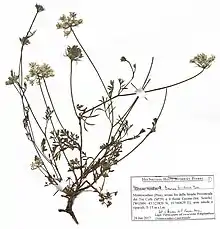| Daucus broteri | |
|---|---|
 | |
| Flower umbel of Daucus broteri | |
| Scientific classification | |
| Kingdom: | Plantae |
| Clade: | Tracheophytes |
| Clade: | Angiosperms |
| Clade: | Eudicots |
| Clade: | Asterids |
| Order: | Apiales |
| Family: | Apiaceae |
| Genus: | Daucus |
| Species: | D. broteri |
| Binomial name | |
| Daucus broteri Ten. (1830) | |
| Synonyms[2] | |
| |
Daucus broteri, commonly known as Brotero's carrot,[3] is a wild relative of Daucus carota that can be found across the northeast Mediterranean and the Middle East.[4] It grows in cultivated and plantation-type land.[1]
Description

Daucus broteri forms disc-shaped bunches of white flowers called Umbels that bloom between April and August.[5] It grows up to 10 to 30 cm with an upright stem that's heavily branched at the base with a single, long taproot and leaves that are bi-pinnate.
Occurrence
Daucus broteri occurs in the eastern Mediterranean region. It grows in fields and on the coast. Its distribution area includes Italy, Albania, Greece, Macedonia, Bulgaria, Crete, the Aegean, European and Asian Turkey, Cyprus, Syria, Lebanon, Jordan, Israel and the Sinai Peninsula.[6]
References
- 1 2 The IUCN Red List of Threatened Species. "Daucus broteri". IUCN Red List of Threatened Species: e.T172136A6834136. Retrieved 22 February 2022.
- ↑ "broteri", Royal Botanical Gardens Kew, retrieved 22 February 2022
- ↑ "Daucus broteri(DAUBR)", EPPO Global Database, retrieved 21 February 2022
- ↑ "broteri distribution", Royal Botanical Gardens Kew, retrieved 22 February 2022
- ↑ "broteri phenology", Flora of Israel Online, retrieved 22 February 2022
- ↑ R. Hand (2011): Apiaceae. – In: Euro+Med Plantbase - the information resource for Euro-Mediterranean plant diversity. Datenblatt Daucus
 Data related to Daucus broteri at Wikispecies
Data related to Daucus broteri at Wikispecies Media related to Daucus broteri at Wikimedia Commons
Media related to Daucus broteri at Wikimedia Commons
